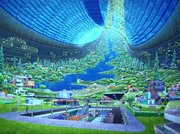Stanford torus
|
|
The Stanford torus is a proposed design for a space habitat capable of housing approximately 10,000 permanent residents. It consists of a torus or donut-shaped ring that is one mile in diameter and rotates once per minute to provide Earth-normal gravity on the inside of the outer ring via centrifugal force.
Sunlight would be provided to the interior of the torus by a system of mirrors. The ring would be connected to a hub via a number of "spokes", which would serve as conduits for people and materials travelling to and from the hub. Since the hub would be at the center of the station, it would experience the least artificial gravity and would be the easiest location for spacecraft to dock. Zero-gravity industry could be performed in a non-rotating module attached to the hub's axis.
Spacecolony5.jpeg
The interior space of the torus itself would be used as living space, and would be large enough that a "natural" environment could be simulated; the torus would appear similar to a long, narrow, straight glacial valley whose ends curved upward and eventually met overhead to form a complete circle. The population density would be similar to a dense suburb, with part of the ring dedicated to agriculture and part to housing.
The Stanford Torus was proposed during the 1975 NASA Summer Study, conducted at Stanford University, with the purpose of speculating on designs for future space colonies. (Gerard O'Neill later proposed his Island One or Bernal sphere as an alternative to the torus.) "Stanford torus" refers only to this particular version of the design, as the concept of a ring-shaped rotating space station was previously proposed by Wernher von Braun in 1952.
Further resources
See also: Bernal sphere, O'Neill cylinder, Space Colony (Gundam)
External links
- Space Settlements: A Design Study, NASA Publication SP-413 (http://lifesci3.arc.nasa.gov/SpaceSettlement/75SummerStudy/Table_of_Contents1.html)

